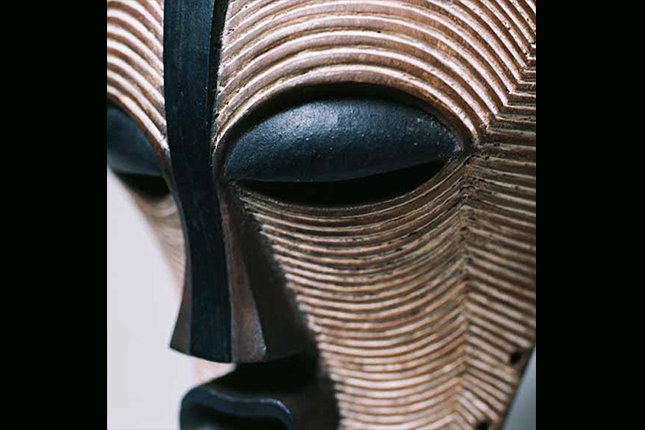Text by:
Clement Onn
Curator, Asian Civilisations Museum,
Jenna Goh
Assistant Researcher, Asian Civilisations Museum
BeMuse Volume 4 Issue 1 – Jan to Mar 2011
Africa, the second-largest continent on Earth, covers an area the combined land mass of Europe, North America and China. It is an enormous land mass rich in geographic and cultural diversity, populated by peoples whose histories date to ancient times. Interactions between its innumerable ethnic groups have created remarkably rich traditions as well as an artistic heritage filled with history and symbolism. Yet whether in terms of size, population or cultural diversity, Africa remains an emotionally foreign location to most Singaporeans.
Jointly organised by the Asian Civilisations Museum (ACM) and the musée du quai Branly (MQB), Paris, Congo River: Arts of Central Africa marked the first showcase of MQB's African collections in Singapore – the result of a Memorandum of Understanding signed in 2009 to intensify cultural cooperation and exchanges between France and Singapore. This jointly organised exhibition ran for four months from 10 December 2010 to 10 April 2011. Featuring over 100 sculptures, masks and other beautifully crafted objects from well known institutions such as musée du quai Branly, Paris; Royal Museum for Central Africa, Tervuren; the National Museum of Ethnology, Leiden and musée national Picasso, Paris, the exhibition was a once-in-a-lifetime visual feast for our visitors and an opportunity to experience the rich artistic traditions behind these masterpieces.
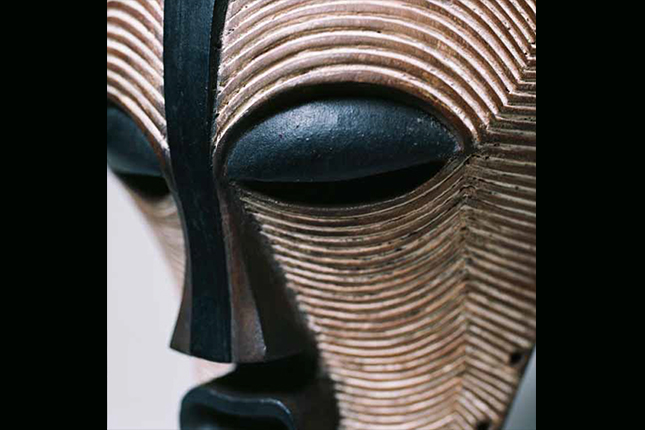
The continent of Africa is dominated by two immense rivers, the Nile and the Congo. Winding for 4,700 kilometres through central Africa, the Congo River passes through many different landscapes, from lush equatorial forests in the north to broad savannahs in the south. For thousands of years, the Congo River has also connected people; as the river carried goods and trade, it also linked culture and art. The majority of the people living around the Congo River and the nearby Ogooué River speak the Bantu family of languages.
Dating back to more than 3000 years ago, the Bantu-speaking people migrated southward into central Africa from Nigeria. There were two large waves which resulted in one of the most significant mass migrations and cultural transmissions in human history. The geographical environments where these people settled down often shaped their perception of the world, expressed through their politics, traditions and belief systems. Powerful kingdoms ruled the open savannahs, such as the celebrated Kongo kingdom; whilst independent groups such as the Fang and Kota lived in dense equatorial forests, governed by lineage groups or communal organisations. In spite of localised differences, these peoples remained tied together not only by the Bantu language, but also in certain commonalities in their art.
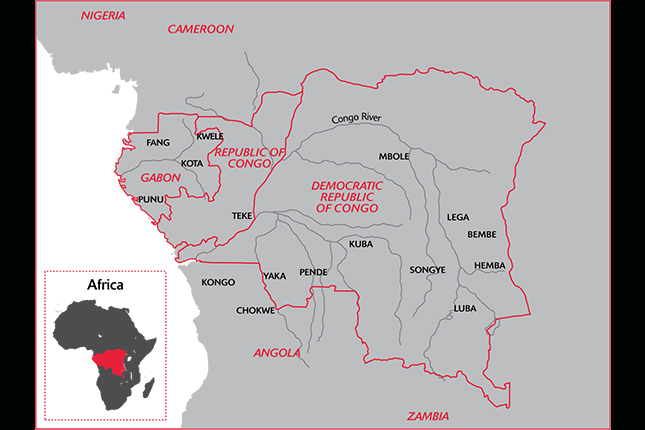
The exhibition Congo River: Arts of Central Africa explored the common artistic heritage of the Bantu-speaking peoples in three broad themes: face masks shaped generally like hearts; statues of ancestors; and the representation of females. The exhibition also included a section on African art’s impact on the larger world. In the late 19th century, European collectors and artists were struck by the visual power of African sculpture. The stylised human forms found in Congo sculptures inspired leading artists to venture beyond naturalism. One such artist was Pablo Picasso (1881-1973), who avidly collected African art. A selection of his works was presented in the exhibition to allow visitors to witness Africa’s influence in the development of Picasso’s Modernist style.
Masks in the Form Of Hearts
Masks in the general shape of a heart can be found all along the Congo River and the Ogooué River to the west. Such masks, mainly of wood or ivory, are usually made by communities living in equatorial rainforests. The forehead and cheeks frame a heart-shaped space that is usually painted white, a colour associated with the realm of ancestors. The white pigment, called mpemba, is made from powdered kaolin, a white clay collected from riverbanks.
A mask would usually be worn at rituals and performances, together with a costume made of leaves, vegetable fibres or textiles. Performances would be accompanied by chants and music. Masked dances were not just entertainment but also served to teach moral values, unify a community, drive away evil spirits, cure sickness, or carry out justice. The wearer of a mask could be transformed into another being associated with supernatural spirits, such as ancestors, heroes or nature. Masked performances were usually carried out during rites of passage (when children become adults, or elders become ancestors) or during ceremonies marking the passage of time or the agricultural cycle.
One highlight in this section was a Kwele mask framed by a pair of long animal horns, representative of benign forest spirits known as ekuk. The horns may be those of the antelope – an important game animal for the Kwele. A skilled sculptor used empty spaces and faceted surfaces to give depth and complexity to the mask. The Kwele associated the forest with the world of spirits or ekuk, who acted as intermediaries between the village and spiritual world. The white paint on the masks was associated with light and clarity, forces that symbolised the ekuk’s ethereal nature and ability to combat evil spirits. As supernatural beings, ekuk were above mortal concerns and could settle disputes amongst villagers.
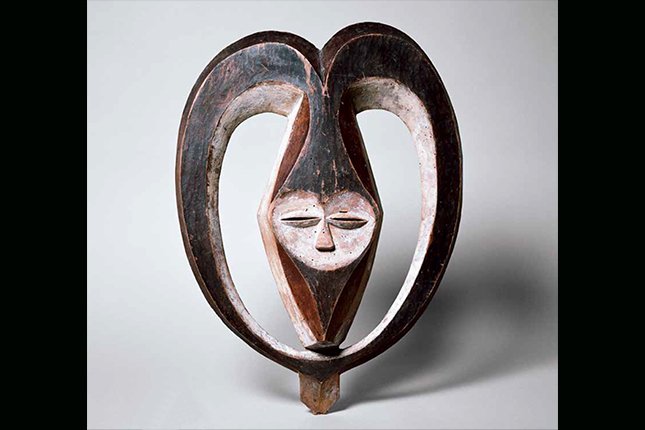
These ekuk masks were used during village ceremonies known as beete that were held in times of need to unify the village against a crisis, like poor hunting or an epidemic. A variety of dances were held during the beete ceremony. In some, the audience participated to foster a sense of unity. Before the ceremonies, young men would hunt, another activity promoting camaraderie. At the end of the ritual, antelope meat and intestines contributed to a ritual stew that was consumed by the whole village.
As such, African masks and other artworks had a utilitarian purpose in daily life. They were not art made for art’s sake, but played a vital role in the fate of the individual and the community. An effective object could secure a successful crop, appear at funerals to comfort the grieving, avert evil forces, or serve as entertainment. Such functionality differentiated African art from a Western understanding of art, which prioritised form and visual aesthetic. African art, by and large, was intricately connected to and widely used in all aspects of daily life. In their original context, these objects were replaced by new ones when they became worn. Sadly, many of the traditions recorded by historians and anthropologists may have faded today. No one can be sure if these activities and rituals are still practised in those parts of Africa. Many of them would be meaningless in present-day Africa whilst some have found new purpose in recent times.
The disc mask from the Teke-Tsaayi community, a model of the versatility and extreme abstraction of a human face, is an example of a mask that has lost its original context of use and taken on a new mantle in its rebirth. In its original context, this mask was worn for kidumu dances that were performed to ceremonially assert and maintain the group’s social and political structures. The mask is divided into two parts at eye level. The upper part protrudes slightly outwards, with narrow slits for the eyes on either side of the small nose to allow the dancer to see. The masked dancers also wore a ring of feathers and a collar of raffia fibre. Often the dancers were young men who performed strenuous acrobatic dances that included cartwheels.
Kidumu dance declined when French colonial powers began moving into the upper Ogooué region at the beginning of the 20th century and people converted to Christianity. Yet in 1963, the dance was recreated with newly made masks to celebrate the inauguration of a railway line. Since then, the kidumu dance has been held for entertainment, and new masks have been made using traditional as well as new designs.
Ancestor Veneration
Ancestor veneration is an important element of central African culture. Vested with mystical powers and authority, ancestors could be called upon to look after their living descendants. Various communities preserved the remains of prominent ancestors – chiefs, warriors, mothers and formidable women – which were stored in bark boxes, woven baskets, or in the cavities of wooden figures. The Fang peoples of Gabon produced among the best-known and highly regarded examples of this genre. Both northern and southern Fang styles are evident in the exhibition: the northern Fang only carved full standing figures, while southern Fang styles have an imposing head with ornate coiffure.
In rituals to honour ancestors, Fang reliquary figures were placed on top of bark cylindrical boxes containing the skulls and bones of revered ancestors. The bones were thought to provide power, wealth and protection to the clan by retaining the deceased’s spiritual essence and serving as a tangible medium for communicating with their spirits. The number of skulls showed the quality of the clan’s lineage; a greater number of skulls signalled an older lineage and more power wielded. The reliquary tradition is a testament to the Fang’s migratory history, as their itinerant existence made permanent ancestral gravesites impossible and necessitated a portable version of ancestral shrines. The variety in form, detail and surface treatment of Fang reliquaries indicate the cultural assimilation that occurred as a result of their contact and conflict with neighbouring peoples.
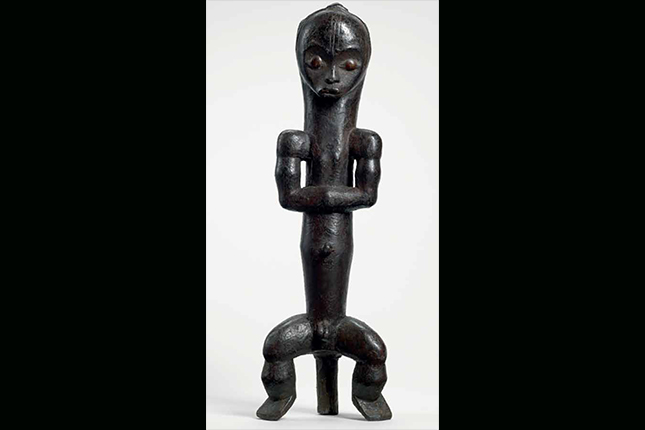
Ancestor figures were also carved by some communities to emphasise family continuity, community bonds, and the claims of chiefs to power. Of special note were the Kota reliquary figures used in ancestral veneration: the reliquaries were placed on baskets that held the bones of deceased relatives, serving as their guardians. The Fang Byeri and Kota Bwete associations were responsible for honouring the family or clan’s most important ancestors, who were often leaders, courageous warriors, superior craftsmen, village founders, fertile women, and individuals with special talents. However, Kota reliquaries were personalised in terms of being owned by a particular family, named, and identified with certain powers. They were also considerably more abstracted than Fang reliquaries, representing the human figure on a flat, planar surface and enveloping it in costly copper or brass sheeting that reflected the importance of the ancestor being honoured. The shine on the metal plating reflected or “threw back” evil. Brass was a precious material in central Africa because it was mainly acquired through trade with Europeans, and served as a form of currency. Kota reliquary figures were among the earliest African artefacts exhibited in France in the late 19th century. Their radically stylised depictions of the human form had a tremendous influence on the development of Western art.
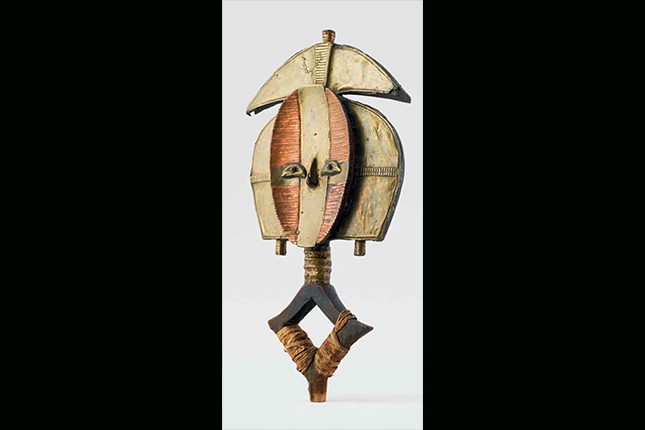
Compared to the representation of ancestors, the representation of rulers in sculpture was rarer, occurring primarily in the royal arts of sub-Saharan African courts, such as the Kuba kingdom in the Democratic Republic of Congo. Remarkable Kuba king figures, known as ndop, were believed to house the counterpart to the king’s soul and served as his surrogate in his absence. Once thought to be literal portraits of specific Kuba rulers, the ndop were actually conventionalised representations, some of which were sculpted posthumously. Their identities were depicted through distinguishing attributes. A key identifying insignia was carved in front of the dais of each statue, such as an anvil or gameboard, which represented a particular characteristic of the ruler’s reign. The exhibition presents the ndop of Miko mi-Mbul of Mushenge, the 110th Kuba king, who lived in the early 19th century. His royal insignia is a human figure. The principal feature of this king’s reign was a change in social customs, when he legalised marriage with slave women. Kuba ndop, like other royal arts, served as a locus of authority, identifying the elite and conveying messages of power to their subjects. Viewers recognised the ndop as a royal personage through its iconography, such as Miko mi-Mbul’s cross-legged pose, the cowrie-ornamented belt, or brass armbands worn only by royalty. Believed to be the embodiment of the king’s and his ancestors’ spirits, ndop were carefully conserved and venerated by following generations. The practice of carving ndop may have been introduced by a Kuba ruler in the 18th century to replace the worship of nature spirits, therefore uniting his subjects by concentrating their loyalty in the person of the king. Thus, although the Kuba did not have a cult of the ancestor in the same vein as the Fang or Kota, certain similarities between the two practices are evident.
Female Representation
In terms of representation, whether in royal arts or other genres in African art, the image of the female was widespread in certain cultural groups. In the cultures of the savannah, women play important roles as rulers, priestesses, honoured mothers and powerful ancestors. The high status of women among the Bantu-speaking peoples is also shown in the principle of matrilineal descent, or the inheritance of leadership through the female line.
The Luba people – whose economic and political power spread their culture to neighbouring groups, such as the Hemba – were renowned for extensively depicting women in their art. This reflected the high status of women in Luba society and government. In Luba caryatid stools, female figures commonly made up the supporting structure, balancing the sitter on her head and palms. Only the king owned a caryatid stool and had the right to sit during ceremonies. The stool was otherwise hidden in another village when not in use, wrapped in white cloth and guarded to avoid theft or tampering. It was a highly spiritual and symbolic object, not for everyday use, but only brought out for special occasions. The female caryatid represented the female founder, symbolically connecting the current ruler to his ancestors.
As the line of ancestral continuity occurred through the woman, females were also associated with fertility and the cycle of life. By virtue of being child-bearers, they were the only ones deemed strong enough to contain great spirits and secret knowledge in their bodies. The caryatid stool symbolised this belief. Upon the king’s death, his royal stool became a receptacle of his spirit, which only a female spirit medium, a Mwadi, had the strength to incarnate. As the living incarnation of the deceased ruler, a Mwadi inherited the king’s royal titles, emblems, and residence, receiving gifts regularly from the new king. Upon her death, she was succeeded by another Mwadi to ensure the continuance of the royal spirit.
The female figure in Luba culture stood for different aspects of women simultaneously: their supporting role in society, ancestral continuity through the female line, important women in government, and their sacred association with the spiritual. Female figures also portrayed idealised physical perfection, expressed in very detailed scarification patterns and coiffures on the sculpted figures. It was not unheard of for Luba women to travel all the way to the capital to view a caryatid’s keloids or hairstyle to learn what was in vogue. Beauty was profoundly important to the Luba, who believed that beautiful coiffure and scarification indicated a civilised, elegant individual and provided a measure of the person’s worth. In most African cultures, beauty and goodness were equivalent. Not only was it a sign of beauty, but elaborate scarification was also an indication of a woman’s strength to bear children. Scarification and coiffures were also forms of identification, signalling to others the person’s profession, rank, and personal history. Patterns and coiffures were meticulously reproduced in otherwise generic ancestral statues to indicate their identity. Patterns could be combined in myriad ways to create different meanings, and were added throughout a person’s lifetime to reflect their new experience and identity.
Punu masks, also known as okuyi dance masks, combined idealised feminine beauty and female association with spirits. Like other masking traditions in Gabon, such as the Kwele and Fang, okuyi masks were painted with kaolin, which was associated with healing, the spiritual, and the dead. The white base and appearance were long thought to be related to Japanese Noh theatre, but the style was indigenous to the Punu and its surrounding neighbours. Yet unlike other Gabon masks, the okuyi were less abstracted and tended towards greater naturalism. Punu carvers based them on the most beautiful woman in the community. The okuyi represents the spirit of a beautiful girl, indicated by the red lozenge scarification on her forehead, returning from the dead to the living world in times of mourning. Although a female mask, it was worn by a male performer in full body costume, who executed astonishing acrobatic moves on stilts in a dance known as mukudj. Once restricted to initiates, the okuyi dance is presently performed in public as a reassertion of the community’s cultural identity. By combining the symbolism of white kaolin and feminine beauty, the woman is intricately linked to the spiritual world.
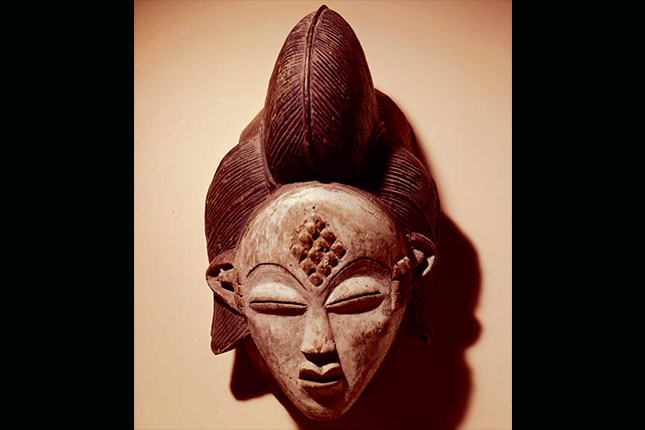
Picasso and African Art
Since the Portuguese arrived in central Africa in the 1500s, travellers have brought African objects to Europe. Collecting increased significantly with the colonisation of the Congo region in the mid-19th century. One of the first displays of African objects took place in Paris in 1887 when some Kota objects from Gabon were exhibited.
The art of Africa was startling to European eyes, especially in the way certain features of the human form were abstracted and exaggerated. In the early 20th century, Henri Matisse, André Derain, Amedeo Modigliani and Pablo Picasso were inspired by African sculpture to move beyond traditional ideas of realism. Matisse was so intrigued that he used them as his inspiration for a portrait of his wife. African objects – with their refined form, gentle concave faces and abstract yet expressive features – attracted the admiration of Western art scholars and collectors. The concave surface was distinct from the prevalence of convex surfaces in Western art, appearing only with Cubism.
Yet despite genuine admiration of stylisation in African art, Western understanding was limited to the visual and emotional. Artworks were analysed without regard for the original culture that produced them, much less the cosmological context that imbued African art with spiritual and symbolic meaning. Paul Guillaume (1891- 1934), a French art dealer wrote that learning the meaning of African art may ”obscure one’s vision of the objects as sculpture”.
Picasso’s first encounter with African sculpture may have been when his friend Matisse showed him a Kongo figure in 1906. The next year, Picasso saw African art at the ethnographic museum in the Palais du Trocadéro, Paris. He claimed that this encounter led him to understand what it meant to be an artist. Beginning in 1907, Picasso collected African masks and sculptures, with a taste for startling pieces and objects showing both human and animal characteristics. Picasso initially refused to acknowledge the role of African art on his works, candidly declaring, “African art? Never heard of it!” Only in his later years did he finally agree that they had a great influence.
Picasso was profoundly inspired by his encounter with African art and its influence is evident throughout most of his artworks in his career. It was one of several factors that shattered the inherited concept that art should imitate nature. Instead, Picasso realised that artists should instead interpret what they see, think and feel. He once said, “Who sees the human face correctly: the photographer, the mirror, or the painter?” The painting, Dimanche (Sunday) is almost unrecognisable as a human portrait. The artist deconstructed and abstracted certain forms – that is, emphasised certain shapes and qualities – inviting the viewer to reflect on the artist’s emotions and imagination. In the exhibition, there are four artworks from the musée national Picasso, Paris that reflect strong influences from African sculpture, ranging from the early years (often referred to as Picasso’s African period, i.e. 1907-1909) right up to 1971, two years before his death.
Conclusion
Recent studies of African art have frequently taken the approach of conducting stylistic analysis according to cultural groups. However, present studies take pains to avoid stringently limiting particular groups with certain styles, and for good reason – not only formal styles, but underlying beliefs are demonstrably shared by various peoples and cannot be limited by group boundaries. Transmitted via trade, travel and warfare, cultures have been absorbed, assimilated and adapted to fit into each community’s particular preferences.
Societies differ in their respective details, whether they were ruled by kings or clans, or in the precise adornment of their statuary. Yet unifying themes abound in stylistic formalities, the shared principle of ancestor veneration, the indistinct borders between the sacred and profane worlds, the special place of women in African society, and the importance of masquerades and ceremonies in uniting a community. A survey of African art across as broad a spectrum as central Africa would no doubt reveal innumerable differences and unique aspects, but threads remain that tie them together over centuries of eventful history and change.
Notes




